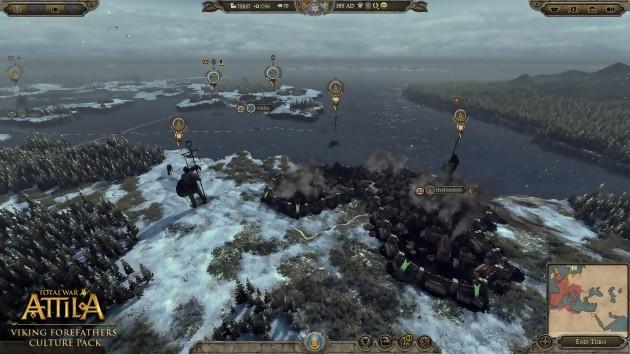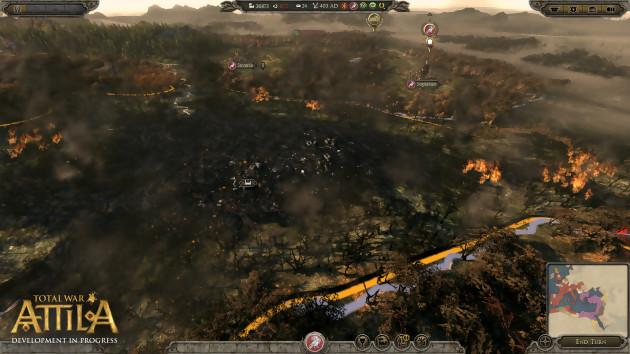 Fundamentally interesting, the historical period covered by the game coincides with the fall of Rome, around the year 400. Apart from pre-order bonuses, downloadable content and other shameful ways of extorting more and more money from you, Total War: Attila offers ten factions, grouped into five categories: the Barbarian Kingdoms (Franks and Saxons), the Great Migrants (Ostrogoths, Alans, Vandals and Visigoths), the Nomadic Tribes (Huns), the Roman Empire (Eastern Roman Empire and Western Roman Empire) and the Eastern Empires (Sasanian Empire). For the Nordic Peoples (Geats, Jutes and Danes), it will therefore be necessary to go through the DLC box. Unfortunately, we are starting to get used to these processes with Total War, which even dare to market special effects packs intended to display more blood on the screen (Total War: Shogun 2 - Blood Pack DLC, Total War: Rome II - Blood & Gore…). But back to our sheep, or rather to our nomads. Not inclined to a sedentary life, the migratory peoples and the Huns play out a little differently from the others on the strategic map. Indeed, these factions do not have a starting province, their armies also acting as mobile cities. It is still possible to establish a camp for a few turns and to build different structures, but the general philosophy remains rather to loot, destroy and advance. In this, the game remains faithful to the adage that the grass dies where Attila's horse passes. Conversely, the Romans must defend their immense empire, attacked from all sides, and cannot allow themselves to set out inconsiderately to conquer other territories. These differences in the gameplay are accompanied by some welcome novelties, which do not upset the gaming experience but are still good to take.
Fundamentally interesting, the historical period covered by the game coincides with the fall of Rome, around the year 400. Apart from pre-order bonuses, downloadable content and other shameful ways of extorting more and more money from you, Total War: Attila offers ten factions, grouped into five categories: the Barbarian Kingdoms (Franks and Saxons), the Great Migrants (Ostrogoths, Alans, Vandals and Visigoths), the Nomadic Tribes (Huns), the Roman Empire (Eastern Roman Empire and Western Roman Empire) and the Eastern Empires (Sasanian Empire). For the Nordic Peoples (Geats, Jutes and Danes), it will therefore be necessary to go through the DLC box. Unfortunately, we are starting to get used to these processes with Total War, which even dare to market special effects packs intended to display more blood on the screen (Total War: Shogun 2 - Blood Pack DLC, Total War: Rome II - Blood & Gore…). But back to our sheep, or rather to our nomads. Not inclined to a sedentary life, the migratory peoples and the Huns play out a little differently from the others on the strategic map. Indeed, these factions do not have a starting province, their armies also acting as mobile cities. It is still possible to establish a camp for a few turns and to build different structures, but the general philosophy remains rather to loot, destroy and advance. In this, the game remains faithful to the adage that the grass dies where Attila's horse passes. Conversely, the Romans must defend their immense empire, attacked from all sides, and cannot allow themselves to set out inconsiderately to conquer other territories. These differences in the gameplay are accompanied by some welcome novelties, which do not upset the gaming experience but are still good to take.
THE HUNS AGAINST THE OTHERS
 This is the case for the interface, redesigned for greater clarity, or even the return of the usual family tree, which had been replaced in Total War: Rome II by an unconvincing internal policy system. We can't help but see in this trial and error a Windows-like syndrome (deletion or replacement of certain functionalities... whose return we finally celebrate later) but for once, things have at least the merit of go in the right direction. We can also note some improvements with regard to real-time battles. Thus during sieges, defensive structures can be placed on predefined locations. And fire can now spread through cities, becoming your greatest asset or your worst nightmare. Everything is displayed naturally through high-end graphics, unfortunately capable of bringing the most powerful PCs to their knees. We also do not fail to rail against the time required for the artificial intelligence to perform its movements during the turn-based phases. More generally, Total War: Attila suffers from problems that are recurring for the series, and which therefore prove to be more and more difficult to excuse over the episodes. This is the case with the diplomacy system, the ins and outs of which we do not always understand, the presence of a few technical bugs, or even the cheap French localization, which uses very unconvincing actors. All this contributes to making Total War: Attila a simple extension of Total War: Rome II disguised as a full game. We would have liked a little more novelty and ambition, even if it means slowing down the pace of release of the various episodes.
This is the case for the interface, redesigned for greater clarity, or even the return of the usual family tree, which had been replaced in Total War: Rome II by an unconvincing internal policy system. We can't help but see in this trial and error a Windows-like syndrome (deletion or replacement of certain functionalities... whose return we finally celebrate later) but for once, things have at least the merit of go in the right direction. We can also note some improvements with regard to real-time battles. Thus during sieges, defensive structures can be placed on predefined locations. And fire can now spread through cities, becoming your greatest asset or your worst nightmare. Everything is displayed naturally through high-end graphics, unfortunately capable of bringing the most powerful PCs to their knees. We also do not fail to rail against the time required for the artificial intelligence to perform its movements during the turn-based phases. More generally, Total War: Attila suffers from problems that are recurring for the series, and which therefore prove to be more and more difficult to excuse over the episodes. This is the case with the diplomacy system, the ins and outs of which we do not always understand, the presence of a few technical bugs, or even the cheap French localization, which uses very unconvincing actors. All this contributes to making Total War: Attila a simple extension of Total War: Rome II disguised as a full game. We would have liked a little more novelty and ambition, even if it means slowing down the pace of release of the various episodes.


























